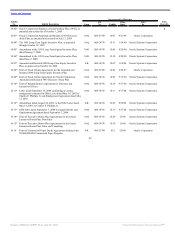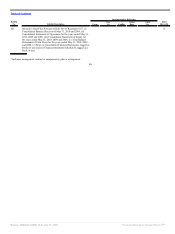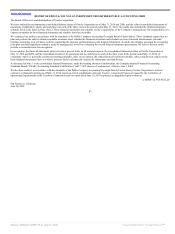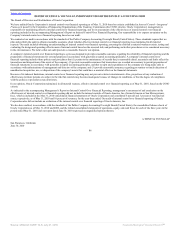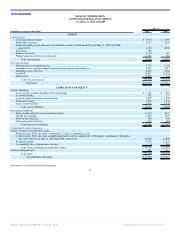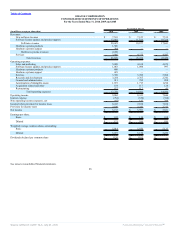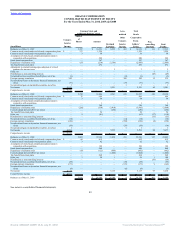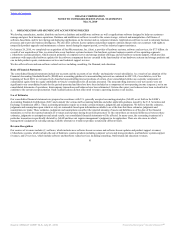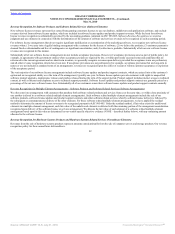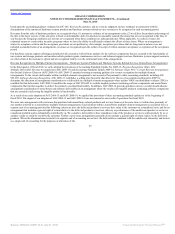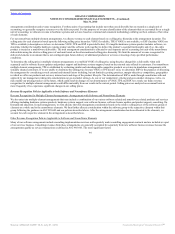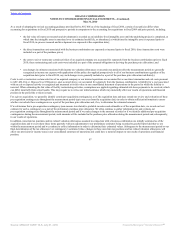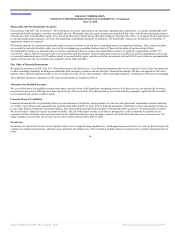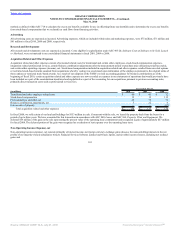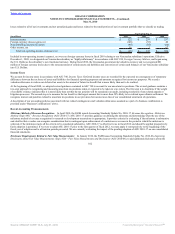Oracle 2009 Annual Report Download - page 96
Download and view the complete annual report
Please find page 96 of the 2009 Oracle annual report below. You can navigate through the pages in the report by either clicking on the pages listed below, or by using the keyword search tool below to find specific information within the annual report.
Table of Contents
ORACLE CORPORATION
NOTES TO CONSOLIDATED FINANCIAL STATEMENTS—(Continued)
May 31, 2010
Revenue Recognition for Software Products and Software Related Services (Software Elements)
New software license revenues represent fees earned from granting customers licenses to use our database, middleware and applications software, and exclude
revenues derived from software license updates, which are included in software license updates and product support revenues. While the basis for software
license revenue recognition is substantially governed by the accounting guidance contained in ASC 985-605, Software-Revenue Recognition, we exercise
judgment and use estimates in connection with the determination of the amount of software and services revenues to be recognized in each accounting period.
For software license arrangements that do not require significant modification or customization of the underlying software, we recognize new software license
revenues when: (1) we enter into a legally binding arrangement with a customer for the license of software; (2) we deliver the products; (3) customer payment is
deemed fixed or determinable and free of contingencies or significant uncertainties; and (4) collection is probable. Substantially all of our new software license
revenues are recognized in this manner.
Substantially all of our software license arrangements do not include acceptance provisions. However, if acceptance provisions exist as part of public policy, for
example, in agreements with government entities where acceptance periods are required by law, or within previously executed terms and conditions that are
referenced in the current agreement and are short-term in nature, we generally recognize revenues upon delivery provided the acceptance terms are perfunctory
and all other revenue recognition criteria have been met. If acceptance provisions are not perfunctory (for example, acceptance provisions that are long-term in
nature or are not included as standard terms of an arrangement), revenues are recognized upon the earlier of receipt of written customer acceptance or expiration
of the acceptance period.
The vast majority of our software license arrangements include software license updates and product support contracts, which are entered into at the customer’s
option and are recognized ratably over the term of the arrangement, typically one year. Software license updates provide customers with rights to unspecified
software product upgrades, maintenance releases and patches released during the term of the support period. Product support includes internet access to technical
content, as well as internet and telephone access to technical support personnel. Software license updates and product support contracts are generally priced as a
percentage of the net new software license fees. Substantially all of our customers renew their software license updates and product support contracts annually.
Revenue Recognition for Multiple-Element Arrangements – Software Products and Software Related Services (Software Arrangements)
We often enter into arrangements with customers that purchase both software related products and services from us at the same time, or within close proximity of
one another (referred to as software related multiple-element arrangements). Such software related multiple-element arrangements include the sale of our
software products, software license updates and product support contracts and other software related services whereby software license delivery is followed by
the subsequent or contemporaneous delivery of the other elements. For those software related multiple-element arrangements, we have applied the residual
method to determine the amount of license revenues to be recognized pursuant to ASC 985-605. Under the residual method, if fair value exists for undelivered
elements in a multiple-element arrangement, such fair value of the undelivered elements is deferred with the remaining portion of the arrangement consideration
recognized upon delivery of the software license or services arrangement. We allocate the fair value of each element of a software related multiple-element
arrangement based upon its fair value as determined by our vendor specific objective evidence (VSOE – described further below), with any remaining amount
allocated to the software license.
Revenue Recognition for Hardware Systems Products and Hardware Systems Related Services (Nonsoftware Elements)
Revenues from the sale of hardware systems products represent amounts earned primarily from the sale of computer servers and storage products. Our revenue
recognition policy for these nonsoftware deliverables is
92
Source: ORACLE CORP, 10-K, July 01, 2010 Powered by Morningstar® Document Research℠


